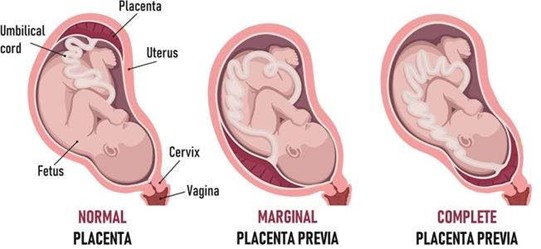A nurse is caring for a client who has a placenta previa. Which of the following findings should the nurse expect?
Nausea.
Polyhydramnios.
Uterine tenderness.
Spotting.
The Correct Answer is D
Placenta previa is a condition where the placenta implants in the lower part of the uterus, partly or completely covering the cervical opening.

This can cause painless, bright red vaginal bleeding, usually in the third trimester. Spotting is a sign of placenta previa and should be reported to the provider immediately. Choice A is wrong because nausea is not a specific finding of placenta previa.
Nausea can occur in normal pregnancy or in other conditions such as hyperemesis gravidarum or preeclampsia.
Choice B is wrong because polyhydramnios is not a finding of placenta previa.
Polyhydramnios is a condition where there is too much amniotic fluid in the uterus, which can cause complications such as preterm labor, cord prolapse, or fetal malformations.
Choice C is wrong because uterine tenderness is not a finding of placenta previa.
Uterine tenderness is a sign of abruptio placentae, which is a condition where the placenta separates from the uterine wall before delivery.
This can cause severe abdominal pain, dark red vaginal bleeding, and fetal distress.
Nursing Test Bank
Naxlex Comprehensive Predictor Exams
Related Questions
Correct Answer is A
Explanation
Prednisone is a corticosteroid medication that can cause bone loss (osteoporosis) by reducing the absorption of calcium and increasing the excretion of calcium in the urine. Therefore, patients taking prednisone should increase their intake of calcium-rich foods or supplements to prevent bone loss and fractures.
Choice B is wrong because prednisone can cause weight gain, not weight loss, by increasing appetite and fluid retention. Patients taking prednisone should monitor their weight and limit their salt and calorie intake.
Choice C is wrong because prednisone should not be taken on an empty stomach, as it can cause stomach irritation, ulcers, or bleeding. Patients taking prednisone should take it with food or milk to protect their stomachs.
Choice D is wrong because prednisone should not be scheduled at bedtime, as it can cause insomnia or difficulty sleeping. Patients taking prednisone should take it in the morning or early afternoon to avoid disrupting their sleep cycle.
Correct Answer is C
Explanation

Valsartan is a medication that lowers blood pressure by blocking the action of angiotensin II, a hormone that causes blood vessels to constrict. By dilating the blood vessels, valsartan reduces the pressure in the arteries and improves blood flow to the organs. However, if the dose of valsartan is too high, it can cause excessive lowering of blood pressure, which can lead to symptoms such as dizziness, fainting, blurred vision, or nausea. This is especially likely when the client changes position from lying or sitting to standing, which is called orthostatic hypotension. Therefore, the nurse should monitor the client’s blood pressure and pulse in different positions and report any significant changes to the provider. The nurse should also instruct the client to rise slowly from a lying or sitting position and to avoid driving or operating machinery until the effects of the medication wear off.
Choice A is wrong because monitoring the client’s urine output is not a priority action for a client who received an overdose of valsartan.
Valsartan does not have a direct effect on urine output, although it may affect kidney function in some cases. The nurse should monitor the client’s serum creatinine and blood urea nitrogen levels to assess kidney function, but this is not as urgent as evaluating the client for orthostatic hypotension.
Choice B is wrong because checking the client for nasal congestion is not a priority action for a client who received an overdose of valsartan.
Nasal congestion is not a common or serious side effect of valsartan. It is more likely to occur with other types of blood pressure medications, such as angiotensin-converting enzyme (ACE) inhibitors or beta blockers.
Choice D is wrong because obtaining the client’s laboratory results is not a priority action for a client who received an overdose of valsartan.
Laboratory results may provide useful information about the client’s electrolyte levels, kidney function, liver function, or blood counts, but they are not as important as assessing the client’s vital signs and symptoms of hypotension. The nurse should obtain the laboratory results after stabilizing the client’s blood pressure and ensuring adequate perfusion to the organs.
Whether you are a student looking to ace your exams or a practicing nurse seeking to enhance your expertise , our nursing education contents will empower you with the confidence and competence to make a difference in the lives of patients and become a respected leader in the healthcare field.
Visit Naxlex, invest in your future and unlock endless possibilities with our unparalleled nursing education contents today
Report Wrong Answer on the Current Question
Do you disagree with the answer? If yes, what is your expected answer? Explain.
Kindly be descriptive with the issue you are facing.
